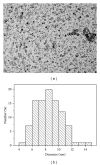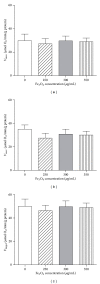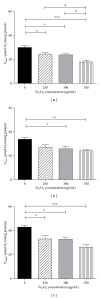Age modulates Fe3O4 nanoparticles liver toxicity: dose-dependent decrease in mitochondrial respiratory chain complexes activities and coupling in middle-aged as compared to young rats
- PMID: 24949453
- PMCID: PMC4032731
- DOI: 10.1155/2014/474081
Age modulates Fe3O4 nanoparticles liver toxicity: dose-dependent decrease in mitochondrial respiratory chain complexes activities and coupling in middle-aged as compared to young rats
Abstract
We examined the effects of iron oxide nanoparticles (IONPs) on mitochondrial respiratory chain complexes activities and mitochondrial coupling in young (3 months) and middle-aged (18 months) rat liver, organ largely involved in body iron detoxification. Isolated liver mitochondria were extracted using differential centrifugations. Maximal oxidative capacities (V(max), complexes I, III, and IV activities), V(succ) (complexes II, III, and IV activities), and V tmpd, (complex IV activity), together with mitochondrial coupling (V(max)/V0) were determined in controls conditions and after exposure to 250, 300, and 350 μ g/ml Fe3O4 in young and middle-aged rats. In young liver mitochondria, exposure to IONPs did not alter mitochondrial function. In contrast, IONPs dose-dependently impaired all complexes of the mitochondrial respiratory chain in middle-aged rat liver: V(max) (from 30 ± 1.6 to 17.9 ± 1.5; P < 0.001), V(succ) (from 33.9 ± 1.7 to 24.3 ± 1.0; P < 0.01), V(tmpd) (from 43.0 ± 1.6 to 26.3 ± 2.2 µmol O2/min/g protein; P < 0.001) using Fe3O4 350 µg/ml. Mitochondrial coupling also decreased. Interestingly, 350 μ g/ml Fe3O4 in the form of Fe(3+) solution did not impair liver mitochondrial function in middle-aged rats. Thus, IONPs showed a specific toxicity in middle-aged rats suggesting caution when using it in old age.
Figures





References
-
- Alexiou C, Tietze R, Schreiber E, Lyer S. Nanomedicine: magnetic nanoparticles for drug delivery and hyperthermia—new chances for cancer therapy. Bundesgesundheitsblatt—Gesundheitsforschung—Gesundheitsschutz. 2010;53(8):839–845. - PubMed
-
- Rumenapp C, Gleich B, Haase A. Magnetic nanoparticles in magnetic resonance imaging and diagnostics. Pharmaceutical Research. 2012;25(5):1165–1179. - PubMed
-
- Corot C, Robert P, Idée J-M, Port M. Recent advances in Iron oxide nanocrystal technology for medical imaging. Advanced Drug Delivery Reviews. 2006;58(14):1471–1504. - PubMed
MeSH terms
Substances
LinkOut - more resources
Full Text Sources
Other Literature Sources
Research Materials

